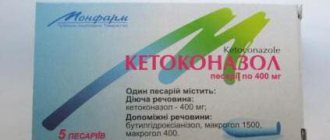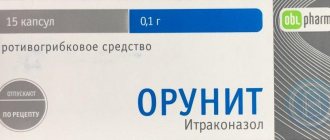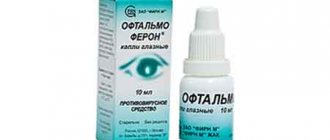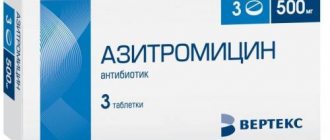Amphotericin B® – instructions for use
The drug belongs to polyene antibiotics, which are the most effective fungicidal agents today. The nephrotoxic effect is due to the slow elimination of the active substance from the body (accumulates in the kidneys).
However, there is an updated version of the drug on the pharmaceutical market - lipid forms of amphotericin B®. They only affect the fungus due to the special structure of the solution, without causing harm to the cells of the body. All dosage forms are sold strictly according to prescription.
Pharmacological group
According to the international classification, the antibiotic belongs to antifungal drugs.
Compound
The active substance of Amphotericin B® is a macrocyclic polyene with the same name as amphotericin B, produced by one of the actinomycetes Streptomyces nodosus. The spectrum of its antimicrobial activity includes many pathogens of systemic mycoses: aspergillus fumigatus, Leishmania, Coccidioides Immitis, Candida, Histoplasma Capsulatum, Paracoccidioides Brasiliensis, Entomophthara Basodiobolus, Absidia, Absidia Blastomyces dermatitidis, cryptococci, rhondotorula, rhizopus, Sporthrix Schenckii.
The principle of fungistatic (and at increased concentrations, fungicidal) action is based on the ability of the drug to integrate into the cell membrane of the fungus, binding to its sterols. As a result, open channels are formed in the wall through which the contents of the cells come out. Amphotericin is active only against fungi and some protozoa, while bacteria and viruses are immune to it.
Read further: How to test urine for flora and sensitivity to antibiotics
Release form of Amphotericin®
Under this trade name, Russian pharmaceutical, AKOMP® and some foreign enterprises produce two dosage forms:
- Lyophilisate – 50 mg (50,000 units) of the active substance in 10 ml glass bottles. The product is intended for dilution and preparation of infusion solution. Photo of amphotericin B® 50,000 mcg (IU) in ampoule
- External ointment in aluminum tubes (10 or 15 g), 1 gram of which contains 30,000 units of antibiotic.
Oral Amphotericin® suspension, tablets and lozenges are available under other brand names. These dosage forms from foreign manufacturers can only be purchased in online stores.
Oral forms are poorly absorbed from the gastrointestinal tract and have minimal toxicity.
Recipe in Latin
Since from January 2021 all systemic antibiotics are classified as prescription drugs, you can buy Amphotericin® only with a doctor's prescription. The form includes the patient’s full name, name of the drug, its quantity, dosage, and treatment recommendations. The recipe is certified by signature and seal.
Recipe for lyophilisate:
Rp.: Amphotericini B 50,000 units
D.td No. 5
S. Dissolve according to the instructions in 400 ml of glucose solution, inject intravenously every other day, 1/3 of the bottle.
Ointment:
Rp.: Unguenti Amphotericini 3% - 10.0
DS Apply a thin layer to the skin three times a day.
No other dosage forms with the same name are available (for example, Amphotericin® suspensions, tablets or suppositories), and therefore prescriptions for them are not written out.
Read more: List of antibiotics that are sold without a prescription
Indications for use
Systemic fungal infections: candidiasis of various localizations, blastomycosis, aspergillosis, sporotrichosis, cryptococcosis, histoplasmosis, candidosepsis, cryptococcal meningitis, mold mycosis, chromomycosis, myocarditis and septicemia of fungal origin and others. The indication for the ointment is candidomycosis of the mucous membranes and skin.
Contraindications
Amphotericin® infusion solution should not be administered in case of renal failure, severe liver pathologies, blood diseases, diabetes mellitus or hypersensitivity to the drug. A relative contraindication is pregnancy - the drug is prescribed with caution. Breastfeeding is stopped during treatment.
The patient's condition requires constant monitoring and laboratory tests of blood and urine.
Amphotericin B® dosage
The solution for infusion is prepared in stages. First, the contents of the bottle are diluted in 5 or 10 ml of distilled water (or water for injection). Next, the resulting solution must be added to a glucose solution (5%, 400 ml). It is impossible to prepare the drug in sunlight - the active substance is destroyed. When a precipitate appears, the solution is no longer suitable for use.
Intravenous infusions
The individual dose is calculated before each infusion: the patient must be weighed, and then the required amount of liquid must be accurately calculated: per kilogram of weight - 250 units. To test tolerance, only 100 units per kg are administered for the first time, and subsequently the dosage is increased to therapeutic values. If no side effects are observed, you can increase it to 1000 units per kilogram.
The infusion is performed slowly, over 3-6 hours, no more than 30 drops of Amphotericin® solution per minute. The full course of treatment lasts for a couple of months, during which 2 dozen infusions are performed. The frequency of procedures is once every two days or 1-2 times a week to avoid accumulation of the antibiotic in the body.
Treatment of children is carried out with a gradual increase in doses every 5 infusions (20 in total per course, 2 per week). Specific values are calculated by age and weight; the table shows daily doses in units per kilogram of body weight:
| Child's age | Infusion 1 to 5 | From 6 to 10 | From 11 to 15 | From 16 to 20 |
| 0-3 | 75-150 | 100-250 | 150-350 | 175-400 |
| 4-7 | 100-200 | 150-300 | 175-400 | 200-500 |
| 8-12 | 125-250 | 175-300 | 200-450 | 225-600 |
| 13-18 | 150-300 | 200-400 | 225-500 | 250-700 |
After the first course, a month's break is taken, then the same scheme is repeated. With this treatment method, the severity of side effects is reduced. If intolerance persists, doses are reduced and intervals between procedures are increased.
Inhalations
You can use an inhalation solution with Amphotericin® prepared with 10 ml of distilled water. The required dose is also selected according to the patient’s weight - from 1000 to 2000 units per kg; for inhalers that work only during the inhalation phase, the total amount of the active substance should not exceed 25,000 units. The duration of the procedure is 15 minutes, the frequency is 1 or 2 times daily. It is recommended to take a two-week course of antibiotic therapy and repeat it after another week. You can store the prepared solution for no more than a day in the refrigerator.
The ointment is used to treat candidiasis that affects the skin and mucous membranes. Apply no more than 4 times a day for 10 days.
Eye drops
On the territory of the Russian Federation, the trade name Amphotirecin® is assigned only to ointment and lyophilisate for infusion. And abroad the drug is available in oral dosage form (tablets, suspension) and as ophthalmic agents.
Side effects of Amphotericin B®
Accumulating in the body due to very slow elimination, the antibiotic has a toxic effect on many organs. Side effects are usually the following:
- headache, blurred vision, nervous system disorders;
- febrile symptoms;
- abdominal pain, dyspepsia, diarrhea (an increase in basic liver enzymes is determined in the laboratory);
- decrease in the number of platelets, leukocytes and erythrocytes, arrhythmia, pressure changes;
- arrhythmias, extrasystoles;
- decreased levels of magnesium and potassium;
- allergies in the form of Quincke's edema, itching, rash, and with inhalation - bronchospasm;
- kidney dysfunction with increased levels of nitrogen, creatinine, protein;
- deterioration in general health – weakness, chills, runny nose;
- local reactions to the ointment rarely occur, only in the form of redness and itching with intolerance. Due to infusions, thrombophlebitis may develop at the site of the vein puncture.
In case of severe side effects, intravenous use of liposomal Amphotericin B is recommended. In this drug, the molecules of the active substance are enclosed in a fatty membrane, which dissolves only upon contact with the membrane of the fungus. Due to this, nephrotoxicity is reduced, side effects are rarely observed.
Read further: What to do if you feel sick from antibiotics?
Amphotericin® during pregnancy
The extent to which the antibiotic enters the fetal bloodstream through the placenta is unknown. There is also no reliable data on the results of the drug’s effect on the body during intrauterine development. Therefore, pregnant women can be prescribed the drug only if a safe alternative cannot be found. Breastfeeding women should stop breastfeeding during treatment.
Compatibility of Amphotericin® with alcohol
Considering that the drug is prescribed for health reasons, it is strictly forbidden to combine it with drinking alcohol. Already poor health will be worsened by increased side effects of the medication. In addition, antifungal therapy becomes useless due to alcohol consumption, and mycoses progress.
Amphotericin® analogs
Preparations with identical composition are available under the following trade names:
- Fungizon®
- Fungitericin®
- Tericin®
- Fotericin®
- Fungilin®
- Amphoronal®
The last drug on the list is an analogue of Amphotericin® in oral dosage form (suspension and tablets). Not sold in Russian pharmacies. Western pharmaceutical companies also produce many substitutes for a less toxic liposomal drug: Anolip®, Ambilip®, Amfotek®, Ambisome®, Ampholip®, Fosom®, Fungiliv®.
Amphotericin B
Active substance:
Amphotericin B*
Pharmgroup:
Antifungal agents
Analogs for the active substance:Fungizon | Application area:Gilchrist's disease Dory's disease Rose Lovers Disease Schenck-Berman disease Visceral candidiasis Generalized candidiasis Generalized candidiasis Fungal nail disease Fungal nail infection Fungal diseases of the larynx Fungal nail diseases Fungal infections of skin folds Fungal infections of the conjunctiva Fungal nail infections Fungal infections of the cornea Dermatomycosis of the groin area and smooth skin Ringworm of the trunk Dermatomycosis of nails Dermatomycosis of the trunk Dermatophytosis of the trunk Disseminated candidiasis European blastomycosis Invasive aspergillosis Invasive candidiasis California fever Candidemia Candidiasis of internal organs Candidiasis of internal organs Generalized candidiasis Laryngeal candidiasis Candidiasis of the gastrointestinal tract Intestinal candidiasis Candidiasis of the skin and mucous membranes Perianal candidiasis Candidiasis of the esophagus Candidiasis of the rectum and lower intestine Systemic candidiasis Candidiasis of mucous membranes and skin Candidiasis of the mucous membranes Candidiasis of the mucous membranes of the esophagus Candidiasis due to Candida albicans Candidomycosis Candidomycosis of mucous membranes Coccidiodomycosis Coccidioidosis Coccidioidosis (coccidioidomycosis) Coccidioidomycosis Cryptococcal infection in patients with AIDS Cryptococcal meningitis Cryptococcal meningitis Cryptococcosis in patients with AIDS Interdigital fungal erosion Cryptococcal meningitis Mycosis fungoides Mycosis of the skin Mycosis of the groin area Mycoses of smooth skin of the body Mycoses of the hands Mycoses of nails Mycoses of the feet and large folds Mycotic jam Mycotic eczema Mycotic dermatitis Microsporia of smooth skin Non-invasive intestinal candidiasis Onychomycosis Onychomycosis Acute pseudomembranous candidiasis Dermatophytosis inguinalis Athlete's inguinal Inguinal ringworm Desert rheumatism Rhinocladiasis Rubrophytosis of smooth skin Rubrophytosis of hands North American blastomycosis Systemic aspergillosis Systemic candidiasis Torulez Trichophytosis of the palms Severe invasive forms of candidal infections Fungoid granuloma Chromoblastomycosis Chromomycosis Chronic forms of candidiasis Chronic candidiasis of the mucous membranes Esophageal candidiasis Athlete's hand Athlete's palms Athlete's nails South American blastomycosis South American blastomycosis Cryptococcus |










